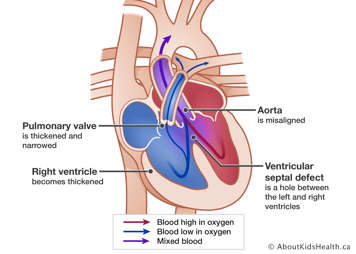Tetralogy of Fallot is a condition of several congenital defects that occur when the heart does not develop normally. "Tetra" is the Greek word for four, meaning that the condition involves four defects, although it is primarily influenced by two major defects.


Tetralogy of Fallot accounts for 3.5% to 9% of heart defects.
This condition involves a ventricular septal defect and pulmonary stenosis. The pulmonary valve may also be small. The other two components are a thickened right ventricle wall and an aorta that is shifted towards the right side of the heart, over the ventricular septal defect. There is sometimes a patent ductus arteriosus through which blood flows from the aorta to the pulmonary arteries.
What are the symptoms of Tetralogy of Fallot?
Symptoms include a murmur. Sometimes, children experience a blue spell.
Tetralogy of Fallot is diagnosed by way of a chest X-ray, an electrocardiogram, and an echocardiogram. Rarely, cardiac catheterization may be needed to confirm the anatomy prior to surgery.
Treatment of Tetralogy of Fallot
If the baby has had a blue spell, medications can help prevent further spells. Surgery will be needed, though not usually right after birth. This may involve putting in a shunt to help blood flow through the pulmonary arteries and closing the ventricular septal defect, or a complete repair.
What are the outcomes of treatment for children with Tetralogy of Fallot?
Repair of this defect is usually very successful. However, in some cases there may be a leaky pulmonary valve. This can take its toll on the right ventricle, and may require a valve replacement. In some cases, the pulmonary valve can narrow over time, requiring more surgery. Heart rhythm problems (arrhythmias) are also a potential risk.